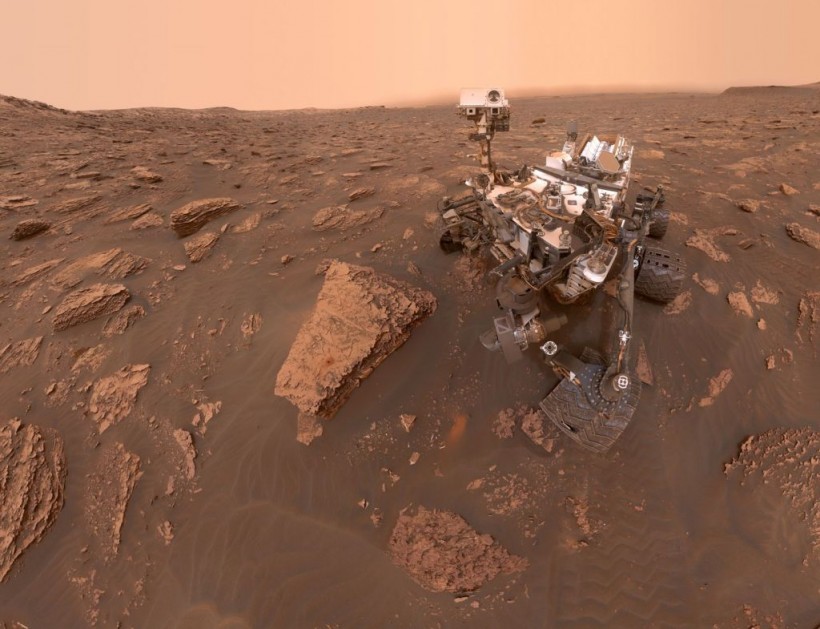NASA released atmospheric imagery that Curiosity Rover got late last year. The Martian clouds seen by the spacecraft are eerily similar to those seen on Earth.
Though it may still host interesting alien clouds today, Mars' atmosphere wasn't always thin. Its atmosphere has weakened over billions of years, but planetary scientists believe it was once thick enough to support a warm world with flowing water.

MOUNT SHARP, MARS - JUNE 20: A self-portrait of NASA's Curiosity Mars rover shows the robot at a drilled sample site called "Duluth" on the lower slopes of Mount Sharp in Mars on June 20, 2018. A Martian dust storm reduced sunlight and visibility in Gale Crater. The north-northeast wall and rim of the crater lie beyond the rover, their visibility obscured by atmospheric dust.
NASA Mars Curiosity Rover Sees Clouds on The Martian Skies
On Thursday, February 17, Curiosity Rover tweeted the joyful news. The post described the GIF as "simply clouds moving through the Martian sky." Experts say the clouds are 80 kilometers (50 miles) above Curiosity's observation location.
It's worth noting that the team handling Curiosity Rover altered the raw photographs digitally to bring out the clouds and shadows.
☁️ Just clouds drifting through the Martian sky. These wisps were ~50 miles (80 km) above me & the height suggests they’re made of carbon dioxide ice. These digitally-enhanced images from one of my navigation cameras were put together into 8-frame GIFs. https://t.co/msDbzywWMP pic.twitter.com/Rwhaot29nq
— Curiosity Rover (@MarsCuriosity) February 17, 2022
According to NASA, the GIF was an 8-frame video generated using photos from a navigation camera aboard NASA's Curiosity rover.
They also claimed that a second 8-frame clip captured by the same navigation camera assisted them in solving a problematic Martian Skies challenge.
Martian clouds are pretty faint in the atmosphere to give you a sense of scale. Because these clouds are so far above the ground, scientists believe carbon dioxide ice formed it. Although the concept is appealing, it is challenging for the Curiosity rover to detect. The Martian sky will be almost undetectable in pictures when contrasted to water ice clouds.
How Curiosity Saw Skies of Mars
To examine the Martian sky, astronomers had to employ specialized imaging techniques. They took advantage of Curiosity's powerful cameras for this novel sky-watching method.
According to Space.com, researchers took "several photos to be able to capture a crisp, steady backdrop." NASA gave Curiosity to observe a patch of sky with a pristine steady background.
ALSO READ: Life on Mars Conspiracy Theory Claims Spotting A Figure Posing Like Kate Winslet in 'Titanic'
Researchers could detect "anything else moving inside the picture" after becoming familiar with the image. It's important to note that these are Martian clouds and shadows.
Researchers ultimately assembled the data after "subtracting (the) static backdrop from each individual image." The clouds moved in an animated-like manner as a result of this.
Experts then used this information to compute the speed and height of the clouds.
They also believed that this find would reveal information about its composition. Regrettably, reseachers did not go into detail about their results.
The task was no simple feat, especially because NASA did not make Curiosity's cameras to stare up into the sky.
Curiosity's initial aim and purpose were to image rocks, examine landscape characteristics, and look for old traces of habitability.
With its most recent accomplishment, this robot, without a doubt, exceeded expectations.
Curiosity arrived on Mars on August 6, 2012, Daily Mail said. The spacecraft has collected and analyzed rock samples in Gale Crater ever since, sending the information back to Earth.
However, Curiosity rover is nearing the end of its ten-year mission to Mars. However, it's possible that it still has a lot of discoveries to make in the future, so fans should remain tuned.
RELATED ARTICLE: NASA Mars Curiosity Rover Finds Carbon On Red Planet; What Does It Mean?
Check out more news and information on Space in Science Times.














